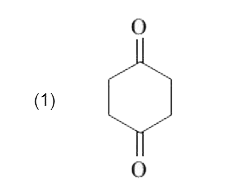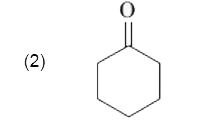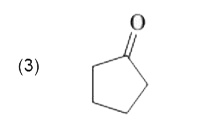A Pci5−−→BPd/BaSO4−−−−−→cConc.H2SO4−−−−−−−−−→0∘C D in the above reaction A, B, C & D are :
CH3COOH, CH3COCl, CH3CHO, Metaldehyde
CH3COOH, CH3COCl, CH3CHO, Paraldehyde
CH3COOH, CH3COCl, CH3−CH2OH, Paraldehyde
None of these
The correct Answer is:A
To solve the question, we need to identify the compounds A, B, C, and D in the given reaction sequence:
1. Identify Compound A:
- The first step involves the reaction of acetic acid (CH3COOH) with PCl5.
- PCl5 is a reagent that converts carboxylic acids into acyl chlorides.
- Therefore, when acetic acid reacts with PCl5, it forms acetyl chloride (CH3COCl).
- So, A = CH3COOH (Acetic Acid)
2. Identify Compound B:
- The next step involves the reaction of acetyl chloride (A) with Pd/BaSO4.
- This is a Rosenmund reduction, which reduces acyl chlorides to aldehydes.
- The product of this reaction is acetaldehyde (CH3CHO).
- So, B = CH3COCl (Acetyl Chloride)
3. Identify Compound C:
- The subsequent step involves the reaction of acetaldehyde (B) with concentrated H2SO4 at 0°C.
- This reaction leads to the formation of paraldehyde, which is a cyclic trimer of acetaldehyde.
- So, C = CH3CHO (Acetaldehyde)
4. Identify Compound D:
- Finally, the product formed from the reaction of acetaldehyde under the specified conditions is paraldehyde.
- Paraldehyde can be represented as (C2H4O)3 or as a cyclic structure of three acetaldehyde units.
- So, D = Paraldehyde
Summary of Compounds:
- A = CH3COOH (Acetic Acid)
- B = CH3COCl (Acetyl Chloride)
- C = CH3CHO (Acetaldehyde)
- D = Paraldehyde
- The first step involves the reaction of acetic acid (CH3COOH) with PCl5.
- PCl5 is a reagent that converts carboxylic acids into acyl chlorides.
- Therefore, when acetic acid reacts with PCl5, it forms acetyl chloride (CH3COCl).
- So, A = CH3COOH (Acetic Acid)
- The next step involves the reaction of acetyl chloride (A) with Pd/BaSO4.
- This is a Rosenmund reduction, which reduces acyl chlorides to aldehydes.
- The product of this reaction is acetaldehyde (CH3CHO).
- So, B = CH3COCl (Acetyl Chloride)
- The subsequent step involves the reaction of acetaldehyde (B) with concentrated H2SO4 at 0°C.
- This reaction leads to the formation of paraldehyde, which is a cyclic trimer of acetaldehyde.
- So, C = CH3CHO (Acetaldehyde)
- Finally, the product formed from the reaction of acetaldehyde under the specified conditions is paraldehyde.
- Paraldehyde can be represented as (C2H4O)3 or as a cyclic structure of three acetaldehyde units.
- So, D = Paraldehyde
- A = CH3COOH (Acetic Acid)
- B = CH3COCl (Acetyl Chloride)
- C = CH3CHO (Acetaldehyde)
- D = Paraldehyde
Topper's Solved these Questions
- ALDEHYDES, KETONES & CARBOXYLIC ACIDSBOOK - NARAYNACHAPTER - ALDEHYDES, KETONES & CARBOXYLIC ACIDSEXERCISE - EVALUATE YOURSELF -3
5 Videos
- ALDEHYDES, KETONES & CARBOXYLIC ACIDSBOOK - NARAYNACHAPTER - ALDEHYDES, KETONES & CARBOXYLIC ACIDSEXERCISE - EVALUATE YOURSELF -4
8 Videos
- ALDEHYDES, KETONES & CARBOXYLIC ACIDSBOOK - NARAYNACHAPTER - ALDEHYDES, KETONES & CARBOXYLIC ACIDSEXERCISE - EVALUATE YOURSELF -1
8 Videos
- ALCOHOLS, ETHERS, PHENOLBOOK - NARAYNACHAPTER - ALCOHOLS, ETHERS, PHENOLEXERCISE - Assertion Reaosn
10 Videos
- AMINES & DIAZO COMPOUNDSBOOK - NARAYNACHAPTER - AMINES & DIAZO COMPOUNDSEXERCISE - Subjective type Q.
13 Videos
Similar Questions
Knowledge Check
CH3−C∣∣O−CH3I2−−−−→Na2CO3(A)Ag powder−−−−−→(B)H2SO4−−−→Hg++(C) Product A,B & C are -
AIodoform, Acetylene & AcetaldehydeBTri. iodomethane, Ethyne & AcetoneCIodoform, Ethene & Ethylene glycolDEthene, iodoform & Ethylhydrogen sulphateIn the following sequence of reactions :
TolueneKMnO4−−−−→ASOCl2−−−→BH2/Pd−−−→BaSO4C the product C is :AC5H5COOHBC6H5CH3CC6H5CH2OHDC6H5CHOANH2OH−−−−→BH2SO4−−−→C260−270∘C−−−−−−−−−→H2OD
If 'D' is a polymer nylon–6 then 'A' can be :A B
B C
C DCH3−CH2−CH2−C∣∣O−CH2−CH2−CH3
DCH3−CH2−CH2−C∣∣O−CH2−CH2−CH3
HNO3/H2SO4−−−−−−−−→ANaOH−−−−−→433KB, B is

View SolutionH3C−O||C−OH+C2H518OHconc.H2SO4−−−−−−−→(X)
H3C−O||C−OH+(CH3)3C−18OHconc.H2SO4−−−−−−−→(Y)
In the above reaction (X) and (Y) are respectively:
View SolutionCH3−C≡C−CH3H2−−−−−−→Pd−BaSO4(A)D2−−→Ni(B)
Product (B) of above reaction is
View SolutionIn the following sequence of reactions:
TolueneKMnO4 −−−−−−→ASOCl2 −−−−−→BH2/Pd⏐↓BaSO4 C
the product C is :
View SolutionPhenol NaNO2/H2SO4−−−−−−−−−→BH2O−−→CNaOH−−−→D
Name of the above reaction is
View Solution
